Skellingthorpe
Skellingthorpe is a village and civil parish in the North Kesteven district of Lincolnshire, England. The population of the village at the 2011 census was 3,465.[1] It is situated 3 miles (5 km) west of Lincoln, 4 miles (6 km) southeast of Saxilby, 6 miles (10 km) northwest of North Hykeham and 15 miles (24 km) east of Tuxford.
| Skellingthorpe | |
|---|---|
.jpg.webp) St Lawrence's Church | |
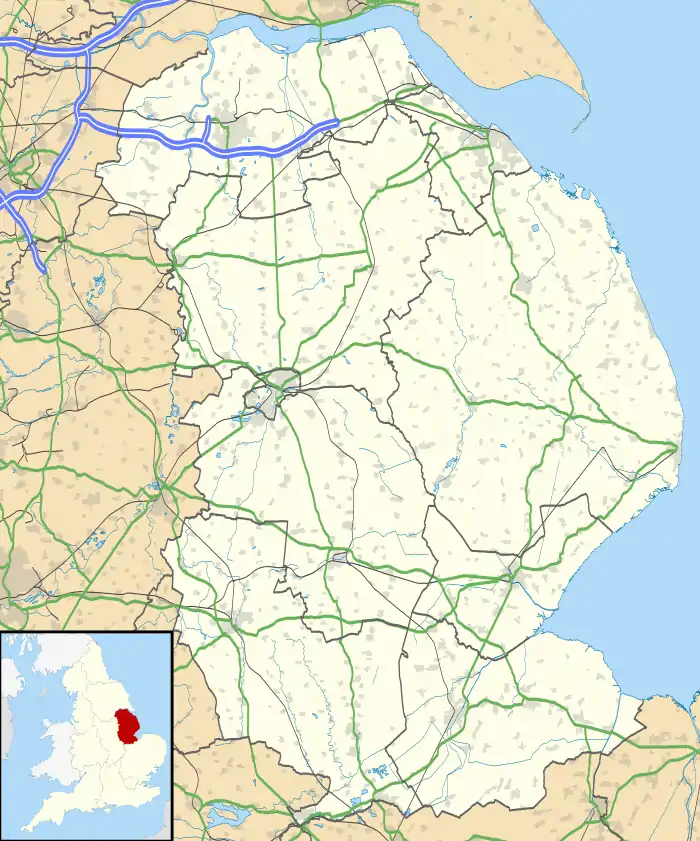 Skellingthorpe Location within Lincolnshire | |
| Population | 3,465 (2011) |
| OS grid reference | SK924719 |
| • London | 125 mi (201 km) S |
| District | |
| Shire county | |
| Region | |
| Country | England |
| Sovereign state | United Kingdom |
| Post town | Lincoln |
| Postcode district | LN6 |
| Police | Lincolnshire |
| Fire | Lincolnshire |
| Ambulance | East Midlands |
| UK Parliament | |
The village of Doddington and Doddington Hall lie 1 mile (1.6 km) to the south-west. Birchwood estate, built in the 1970s on the site of RAF Skellingthorpe, is 1 mile to the south-east.
Toponymy
The earliest-known spelling of its name, Scheldinchope, suggests an enclosure in marsh associated with a man named Sceld.[2] Another theory for the name is that it derives from the Anglo-Saxon words 'scilling' (shilling) and 'thorf' (village) - the 'shilling village'.[3]
Domesday Book (1086) records the name "Scheldinchope" and that it contained 12 carucates of land worked by 18 villeins, two sokemen and four bordars.
Up until the second half of the 18th century Skellingthorpe was pronounced and written ‘Skeldingthorpe’. A periodical in 1785 refers to the presentation of the Rev George Hare to the 'vicarage of Skellen-thorpe otherwise Skeldingthorpe, in the diocese of Lincoln’.[4]
History
A small paleolith found in gravel was presented to the British Museum in 1922, hinting at the presence of some ancient tribe.[5] An ancient hand-axe was reported as being discovered in gravel ballast during the construction of the railway line in 1897.[6] The area was marsh and woodland at the time of the Romans and there is no evidence of a permanent settlement by ancient Britons, although it is possible that nomadic forest or swamp dwellers occasionally passed through.[7]: 4 Roman engineers excavating what is now the Foss Dyke were in the vicinity c. 120 AD as evidenced by a Roman bowl found in the parish. Other Roman-era discoveries include a copper alloy bell found in Main Drain,[8] and 13 coins (dated to the third or fourth century) unearthed in 1978.[9]
The settlement may have originated with Danish occupiers.[10] Around 1953 a blue and white ring (dated by the British Museum to c. 875 AD) was found in Stoney Yard.[7]: 58 This and the fact that the Danes established themselves elsewhere in Lincolnshire by the year 876 reinforce the supposition that Skellingthorpe became a settlement in the late 9th century.[7]: 2
In the Middle Ages the manor was held by the Norman Wak, or Wake, family. On 4 January 1283 the manor of Skeldingho and all Baldwin's other lands were granted to Edmund, Earl of Cornwall; although Baldwin's widow, Hawisia, and others were allowed their rights as adjudged in the king's court.[11]
By the 1360s the manor had passed to Gilbert de Umfraville, 3rd Earl of Angus and Kyme. By February 1399 the manor of Skellingthorpe was all but deserted, with much land left uncultivated through a lack of tenants. In the May the Rectory was appropriated to the Hospital of Spital in the Street (the Spital Charity) by Thomas de Aston (Canon of Lincoln), and they farmed out the rectorial tithes to laymen. The vicar was paid £5 a year by the charity.[7]: 4
On the attainder of Sir William Tailboys, his estates were escheated to the crown and a portion, including Skellingthorpe, were granted to Thomas Burgh and his male heirs by King Edward IV in 1460.[12]
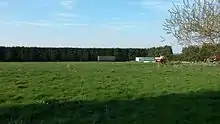
The medieval settlement was in the vicinity of Lower Church Road, to the north of the church and most of the present village. There were three sub-rectangular fishponds, orientated north–south, near Manor Farm. It is unknown at what point that settlement became fully deserted. (In 1981, it was reported that the remains of the fishponds, water channels, ridges and furrows were in excellent condition but by 1987 they had been largely obliterated. The site is now largely given over to livestock.)[13]
In 1563, a Record of Marriages was begun for the parish.[14]
The manor was inherited by Henry Stone.[15] He died aged 62 on 26 June 1693, and the following year the governors of 'Christ Hospitall' in London arranged for a tomb to be erected in his memory, which is now in the grounds of the church. As his relatives had all predeceased him, he willed his estate to Christ's Hospital. His will also benefitted neighbours and tenants, local schools and the church.
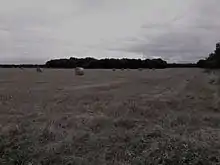
Throughout the late 1600s and early 1700s the village economy stemmed from duck decoys, but began to decline with the drainage and enclosure of the land.[7]: 7–8 The earthwork remains of an old decoy pond, which had been established in 1693, can be found on private land to the east of the village.[16][17] In 2010 it was announced the surviving decoy pond was one of 79 historic sites to be protected under an environmental stewardship scheme, run by Natural England.[18]
In 1710, surveys by Christ's indicated that Skellingthorpe estate consisted of 2,872 acres let to fourteen tenant farmers, 900 acres was newly planted ground, 600 was uncultivated and the rest was wooded.[19]
An 1872 gazetteer of Skellingthorpe records it as "a scattered, but well-built and pleasant village" which consisted of "726 souls, and 6220 acres of land, extending to the Fossdyke... including 600 acres cleared of plantations, and some fertile and well-drained marshes".
In the 1850s a new National Society School, called St Lawrence's after the adjacent church, was established in 1855. Compulsory attendance was not enforced until 1870.[7]: 35–39
By the beginning of the 19th century large parts of the parish were still little more than a morass, and the risk of flood was a constant one. The Catchwater Drain was planned from 1805.[20] By the middle of the 19th century, Skellingthorpe had been well-drained for some time and two small steam engines were erected near the Decoy Farm to pump out floodwater.[21]
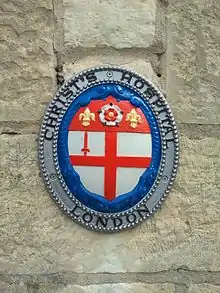

In 1905 an epidemic of typhoid swept Lincoln, killing at least 110 people and making over 1,000 ill. It was alleged that Skellingthorpe's Catchwater Drain, which flowed into the city, contributed to this.
In 1914 Christ's Hospital sold off all their properties in the parish, effectively ending a connection between Skellingthorpe and the capital that had existed for over 200 years.[22] A small number of buildings. including St Lawrence's School, still bear Christ's coat of arms on their gables or wall.
During the 1915–1918 aerial bombardment of Britain by German Zeppelins 14 bombs damaged an engine shed and a railway track at Skellingthorpe on the night of 12/13 April 1918.[23]
A war memorial in the church grounds shows that the village lost 19 men during the Great War, and a further five during the Second World War.
In 1948 there was a proposal to develop RAF Skellingthorpe into a civil airport, but it came to naught.[24]
On 15 July 1949 an RAF bomber from Waddington crashed near Skellingthorpe.
Electricity and running water came in the 1930s. Before this, houses shared pumps that tapped underground wells. The first street lights were erected in 1956–57. Main drainage came in 1964.[25]
By 1971, Skellingthorpe's population had risen steadily to 2,593. This was more than three times what had been just forty years earlier, and thirteen times what it had been in 1801.[7]: 19
A village hall had been built in 1928. By the 1970s this was judged too small.[26] In 1973 a larger Community Centre and Youth Hall were built on the site of the railway station.
In 1986 the BBC Domesday Reloaded project captured a snapshot of the village. Among the village curiosities was an antiquated post-box that still bore the initials of King George VI, despite that monarch having been dead 34 years by that time.[27]
On 26 July 2010 there was an explosion at a bone-meal factory. A second fire at the same plant occurred in the early hours of 16 August 2011.[28]

In July 2015 an event was held in the village to commemorate an incident in 1944 when a Lancaster Bomber that had taken off from RAF Skellingthorpe was shot down over the French village of La Chapelle-Thecle. Six crewmembers died in the incident, and the villagers of La Chapelle-Thecle defied Nazi occupation to lay flowers on the bodies of the airmen.[29]

A slaughterhouse in Skellingthorpe has been the site of a number of small, and peaceful, demonstrations against the treatment of cattle being transported to the premises. The vigils - called ‘Cow Save’ - were organised by the Boston and Skegness Vegans and Vegetarians Group, and occurred in 2016 and 2017, aiming to highlight what they perceived as the animals’ distress before being slaughtered. Some of the demonstrators requested that the transporting lorries be allowed to stop for three minutes so that the animals could be wished a dignified ‘goodbye’.[30]
Transport
Rail

The Great Northern Railway line between Lincoln and Saxilby follows the route of the Fossdyke and skirts the village. For a short while, 1865–1868, there was a railway station at the end of Ferry Lane.
Later the Lancashire, Derbyshire and East Coast Railway passed through the village, and line was built in 1897. The station was closed to passengers in 1955, although the line continued to carry freight until 1979. The route of the line is now a cycle path[31] on a National Cycle Route.
Road
In 1985 the Lincoln Relief Road (A46 Bypass) opened.[32] Part of this route skirts the Skellingthorpe Moor Plantation, although this is obscured by trees. There is a roundabout connecting Lincoln Road with Skellingthorpe Road, Birchwood. Further north, the Relief Road briefly enters the parish of Skellingthorpe, west of the Decoy Farm and the Duck Decoy.
Local buildings
St. Lawrence's Church
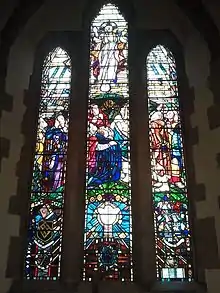
There has been a place of worship in the village since the beginning of the 13th century: the institution of Robert de Weinflet as chaplain to the church of Skellingthorpe is recorded in 1225.[33] Patent Rolls for 1258 (dated 1 October) refer to the "Presentation of Master Raymond, the Queen's physician, to the church of Skeldinghop in the kings gift".[34]
The church was rebuilt in the 19th century, except the tower and chancel arches, at a cost of £2,800. Its new design was described in an 1865 gazetteer as being ‘in the Early English style, consisting of a nave with clerestory over, aisles, chancel, south porch and a tower crowned by a spire and containing a peal of five bells… The East Window is filled with stained glass, in memory of Richard Carline, Esq., and Mrs. Carline’.[35] When the new church was officially opened in 1855 it rained heavily, but this did not deter the crowds that arrived from great distances to participate in the ceremony.[36]
A fire on Sunday 2 April 1916 that destroyed the interior, two of the bells, the organ, the pulpit, the font, cassocks and prayer books. It also destroyed ‘a list of vicars from the year 1297 up to the present time’.
The East Window was presented in 1961 by the Bergne-Coupland family. It was designed by Edward Payne, of Box, Gloucestershire, and depicts the Ascending Christ and his disciples.
Methodist chapel
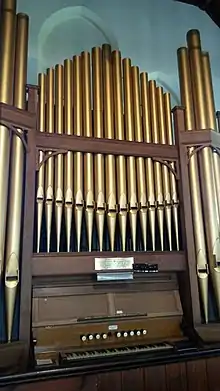
Although a small number of 'Independents' - possibly Congregationalists or Baptists - had been resident in Skellingthorpe since 1796, efforts to preach Methodism in Skellingthorpe were initially unsuccessful. Richard Coupland, a farmer, granted the Methodists the Chaff House, adjoining one of his barns. The Chaff House was also used by the Independents, but in time they appear to have become absorbed into the Methodists. In 1894 the present Methodist Church was established on High Street.[7]: 41–43
Skellingthorpe Hall
Skellingthorpe Hall is to the east of the village and is a Grade II Listed Building.[37] Pevsner describes the hall as, "A Greekly august house of the early C.19. The porch is particularly good, with pilasters at the angles and fluted Greek Doric columns in antis with a finely carved frieze behind them above the entrance'".[38]
Others
The Manor House is also a Grade II Listed Building, dating from around 1811, which formerly went by the name of "West Manor".[39]
Jessup Cottage, off Lower Church Road, is believed to be the oldest house in the village,[40] The cottage is a Grade II Listed Building[41] and may have originated as a school.[42] A well on the premises dates to the late 18th or early 19th century.
St Lawrence's School building was completed in 1856, supported by grants from Christ's and Spittal Hospitals.[43]
The old vicarage off Waterloo Lane dates to 1870 and replaced an earlier one next to the church. The old village blacksmith's was in Stoney Yard. Both properties are now private residences.[7]: 51, 53
Just outside the village, on Saxilby Road, is 'The Cottage', believed to be at least 400 years old and to have once been the village bake-house.[7]: 52
The village sign on Lincoln Road was presented to the parish by the Skellingthorpe Women's Institute in 1982 to celebrate their Diamond Jubilee. Its double-faced design reflects numerous aspects in the parish's history, from its likely Viking origins to the establishment of RAF Skellingthorpe.[44]
Amenities
Old Wood, to the west and now owned by the Woodland Trust, is an ancient woodland forming part of the Witham Valley Country Park. In the Middle Ages it was used as a deer park. It is a varied site with a mixture of ancient oak, lime woodland and conifers. To the west of the village, it merges with the smaller Old Hag Wood. One trail through the woodland is called the Odin Trail, reflecting the possible Viking origins of the village.

There are two village public houses: the Stone Arms and the Plough Inn, both on High Street.
The Village Hall is used by the local scouts as their HQ, and a small Heritage Room at the Community Centre houses a collection of photographs showing the development of RAF Skellingthorpe.
There are two schools: St Lawrence's Primary School and the Holt Primary School.
Jerusalem
Skellingthorpe has a distinct hamlet called Jerusalem which seems to have developed in the early 1890s.[45] Jerusalem Farm also appears to have developed around the same time. About 100 years earlier, brick-making seems to have been carried out in the area.[46]
An early 19th-century Ordnance Survey map shows there was at one time a small Victorian-era Methodist chapel sited between two bends in the road.[47]
Miscellaneous
In 2016 it was reported that some kind of large cat-like animal might be on the prowl in Skellingthorpe, following the discovery of two mutilated hares on the lawn of a 'remote home' in the parish. The smudges of two large paw-prints, slightly smaller than an adult's hand, were also discovered on the window of an outbuilding at the same premises.[48] Rumours of such a visitor to Skellingthorpe date back to 1997, when a large unidentified feline was allegedly sighted.[49]
Gallery
 St Lawrence's Church
St Lawrence's Church Skellingthorpe Hall Lodge on Lincoln Road
Skellingthorpe Hall Lodge on Lincoln Road Skellingthorpe Farm, established in 1813, is now a care home
Skellingthorpe Farm, established in 1813, is now a care home Carved markers populate Old Wood
Carved markers populate Old Wood The woodland entrance at Magtree Hill
The woodland entrance at Magtree Hill Jessup Cottage, believed to be the oldest house in Skellingthorpe
Jessup Cottage, believed to be the oldest house in Skellingthorpe Memorial in church to mid-19th century Carline family
Memorial in church to mid-19th century Carline family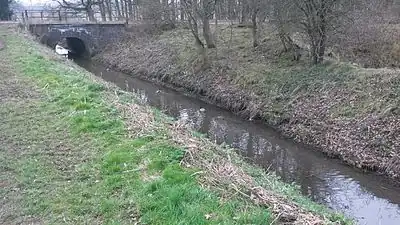 The Catchwater Drain to the east of Skellingthorpe
The Catchwater Drain to the east of Skellingthorpe The 'Willow Weeping' bench, since dismantled
The 'Willow Weeping' bench, since dismantled Lake at Brick Kiln Holt
Lake at Brick Kiln Holt Part of Jerusalem Farm
Part of Jerusalem Farm A now-defunct railway bridge to the west of the village.
A now-defunct railway bridge to the west of the village.
References
- "Civil Parish population 2011". Neighbourhood Statistics. Office for National Statistics. Retrieved 29 May 2016.
- Mills, A. D. (2003); A Dictionary of British Place-Names. Oxford University Press. ISBN 0198527586
- Illustrated London News, p.13 (Saturday 6 June 1857)
- The London Magazine (Volume the Fourth from January to June 1785), Isaac & Edmund Kimber (1785) p.150
- Archaeologia: Or Miscellaneous Tracts Relating to Antiquity, Volume 72, p.26, Archaeological Society (1922)
- Quaternary of the Trent, p.278, edited by David R. Bridgland, Andy J. Howard, Mark J. White, Tom S. White (Oxbow Books, 2014)
- Stevens 1974.
- Lincolnshire History and Archaeology, Volumes 16–19, p.99, Lincolnshire Local History Society (1981)
- Lincolnshire Archives
- Streatfeild, Reverend G. S. (1884). Lincolnshire and the Danes.p.86
- Calendar of the Patent Rolls Preserved in the Public Record Office, Volume 8, p.53 (1893)
- Oldfield, Edmund. A Topographical and Historical Account of Wainfleet and the Wapentake of Candleshoe (1829). p.134.
- Unpublished report for Lincolnshire County Council Archaeological Section (June 1998). See http://archaeologydataservice.ac.uk/archiveDS/archiveDownload?t=arch-1045-1/dissemination/pdf/943_StoneNookHighStreet_Skellingthorpe.pdf
- Lincolnshire Parish Registers: Marriages, Volume 4, p.31 (Issued to the subscribers by Phillimore & Company, 1909)
- Architectural Societies. (1899). Reports and Papers Read at the Meetings of the Architectural Societies… p.302.
- Lincolnshire Archives
- Duck Decoys, p.16, Andrew Heaton (2001). ISBN 0747804974
- Lincolnshire Echo (25 August 2010)
- Report of the Commissioners appointed in pursuance of an Act of Parliament (32 pt. VI), p.155, Commissioners for Inquiring Concerning Charities (dated 30 June 1837)
- Stamford Mercury, p.1 (Friday 29 March 1805)
- Clarke, John Algernon. On the Farming of Lincolnshire. (1852). p.51.
- Wilkins, Harold Tom. Great English Schools. (1925). p.287.
- Sir Walter Alexander Raleigh, Henry Albert Jones. The War in the Air (1935). p.124.
- Mysterious Lincolnshire, p.121, Daniel Codd (2007). ISBN 978-1780913049
- Lincolnshire Echo (The Gossiper column). (6 June 1974). p.8.
- Skellingthorpe Chatterbox, No.351, p.5. (July 2017)
- "BBC - Domesday Reloaded: Skellingthorpe Village". Archived from the original on 31 December 2017. Retrieved 25 December 2019.
- Lincolnshire Echo (27 July 2010, 16 August 2011)
- Lincolnshire Echo, p.16 (30 July 2015)
- ""We've seen cows crying": Protestors hold vigil at Lincoln village slaughterhouse". 30 September 2016.
- "Geograph:: Skellingthorpe © Matthew Smith". www.geograph.org.uk.
- Lincoln: History and Guide, p.76, Michael J Jones (A Sutton, 1993)
- Reports and Papers Read at the Meetings of the Architectural Societies of the Counties of Lincoln and Nottingham, etc, Vol.24 (Associated Architectural Societies, 1897). p.402.
- Patent Rolls of the Reign of Henry III.: 1247–1258, p.652, GB Public Record Office (1908)
- History, Gazetteer and Directory of Lincolnshire, p.612-613, William White (1872)
- Morning Chronicle, p.3 (8 October 1855)
- Stuff, Good. "Skellingthorpe Hall, Skellingthorpe, Lincolnshire". britishlistedbuildings.co.uk.
- Pevsner, Nikolaus. The Buildings of England (Lincolnshire). (1964, 2nd ed.1989). p.646. ISBN 0300096208
- "Manor House, Skellingthorpe, Lincolnshire".
- Skellingthorpe village North Kesteven District Council homepage
- "Jessup Cottage, Skellingthorpe, Lincolnshire".
- Skellingthorpe Parish Council data, http://parishes.lincolnshire.gov.uk/Skellingthorpe/section.asp?catId=18102
- History, gazetteer, and directory of Lincolnshire, p.348. William White (of Sheffield) (1856)
- Plaque in Skellingthorpe's Heritage Room. See http://parishes.lincolnshire.gov.uk/Skellingthorpe/section.asp?catId=18102
- Lincolnshire Chronicle, p.1 (29 March 1892)
- History of the Manor and Township of Doddington, p.245, R.E.G Cole (1897)
- Skellingthorpe Chatterbox No.277. (Parish magazine). February 2011. p.6
- Lincolnshire Echo, page 27 (Thursday 6 October 2016)
- Fortean Times Issue 101 (1997). John Brown Publishing. p.25
Sources
- Stevens, L. (1974). Skellingthorpe: A View through History. Skellingthorpe Evening Institute.
External links
 Media related to Skellingthorpe at Wikimedia Commons
Media related to Skellingthorpe at Wikimedia Commons- St Lawrence's church
- Pictures of Skellingthorpe
- St Lawrence CE Primary School
- Holt Primary School
- Skellingthorpe in the Domesday Book